Intake Manifold Replacement Upper
Removal Procedure
- Remove the PCV tube from the air cleaner outlet duct.
- Remove the air cleaner outlet duct from the throttle body assembly.
Refer to
Air Cleaner Outlet Duct Replacement
in Engine Controls.

- Disconnect the following
electrical connectors:
| • | The A/C pressure switch, if equipped |
| • | The throttle position (TP) sensor |
| • | The idle air control (IAC) motor |
| • | The fuel meter body assembly connector |
| • | The manifold absolute pressure (MAP) sensor |
| • | The EVAP canister purge solenoid valve |
- Remove the EVAP canister purge solenoid valve. Refer to EVAP Canister Purge Solenoid Valve Replacement
in Engine Controls.
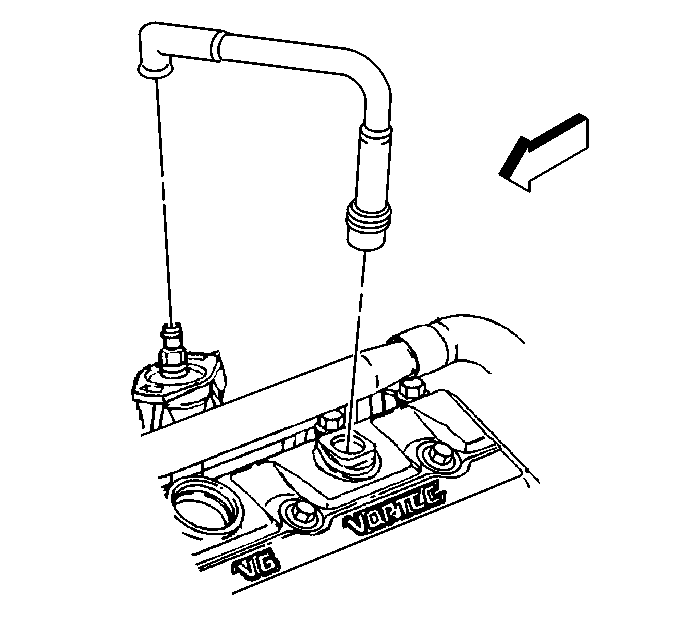
- Disconnect the vacuum
hose for the A/C system from the intake manifold.
- Remove the vacuum brake booster vacuum hose.
- Remove the PCV valve hose from the upper intake manifold.
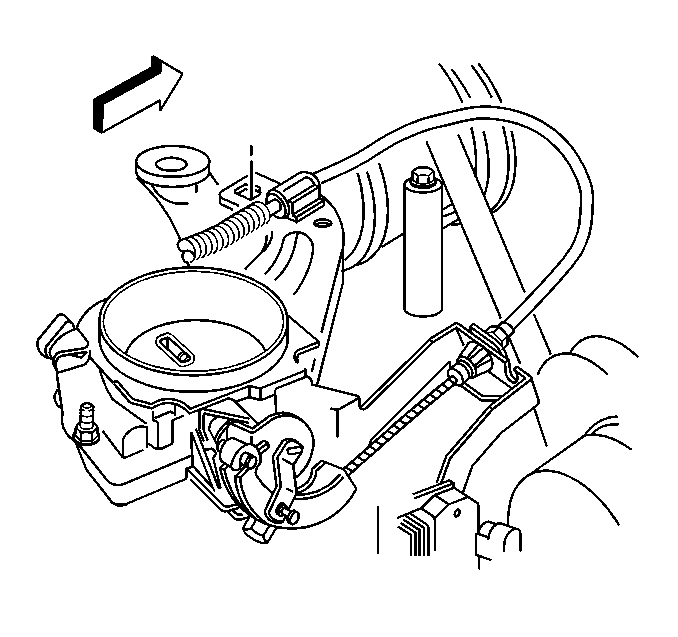
- Disconnect the accelerator
control cable from the throttle shaft.
- Disconnect the cruise control cable.

- Remove the nuts and the
stud on the accelerator control cable bracket from the throttle body and the
intake manifold.
- Remove the accelerator control cable from the throttle body and
the intake manifold. Refer to Accelerator Controls Cable Replacement
in Engine Controls.
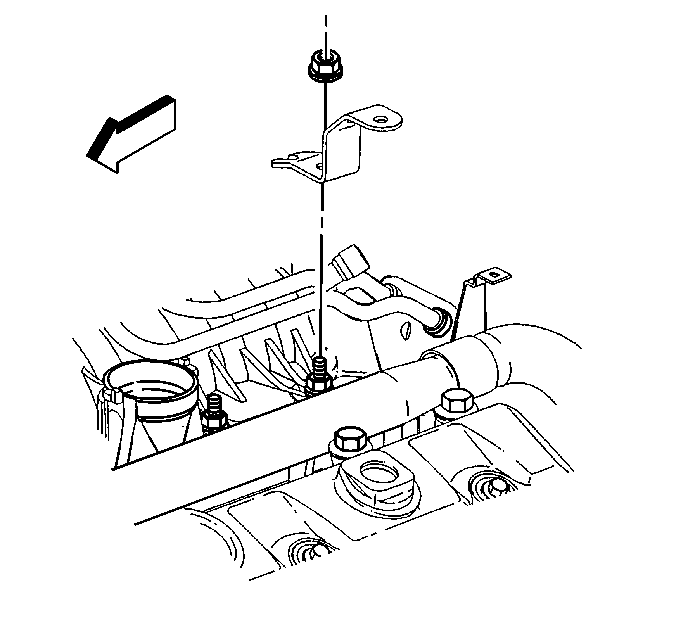
- Remove the nut and the
engine wiring harness bracket from the intake stud.
- Remove the fuel pipes from the fuel meter body assembly. Refer
to
Intake Manifold Disassemble
.
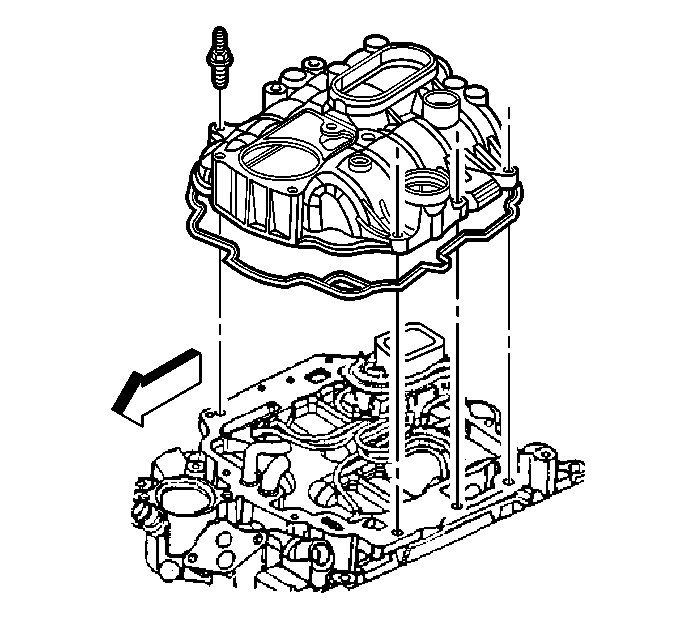
- Remove the upper intake
manifold. Refer to
Intake Manifold Disassemble
.
- Clean all sealing surfaces. Refer to
Intake Manifold Cleaning and Inspection
.
Installation Procedure

- Install the upper intake
manifold. Refer to
Intake Manifold Assemble
.
- Install the fuel pipes to the fuel meter body assembly. Refer
to
Intake Manifold Assemble
.
- Install the engine wiring harness bracket on the intake manifold.
Notice: Use the correct fastener in the correct location. Replacement fasteners
must be the correct part number for that application. Fasteners requiring
replacement or fasteners requiring the use of thread locking compound or sealant
are identified in the service procedure. Do not use paints, lubricants, or
corrosion inhibitors on fasteners or fastener joint surfaces unless specified.
These coatings affect fastener torque and joint clamping force and may damage
the fastener. Use the correct tightening sequence and specifications when
installing fasteners in order to avoid damage to parts and systems.
- Install the engine
wiring harness bracket nut.
Tighten
Tighten the engine wiring harness bracket nut to 12 N·m
(106 lb in).

- Install the accelerator
control cable bracket to the throttle body and the intake manifold.
- Install the stud and the nuts to the accelerator control cable
bracket.
Tighten
Tighten the bracket stud and the nuts to 12 N·m (106 lb in).

- Install the cruise control
cable, if equipped.
- Install the accelerator control cable to the throttle shaft. Refer
to Accelerator Controls Cable Replacement
in Engine Controls.
- Install the EVAP canister purge solenoid valve. Refer toEVAP Canister Purge Solenoid Valve Replacement
in Engine Controls.

- Connect the PCV valve
hose to the upper intake manifold.
- Connect the vacuum hose for the A/C system to the intake manifold.
- Install the vacuum brake booster hose.

- Connect the following
electrical connectors:
| • | The A/C pressure switch, if equipped |
| • | The throttle position (TP) sensor |
| • | The idle air control (IAC) motor |
| • | The fuel meter body assembly |
| • | The EVAP canister purge solenoid valve |
| • | The manifold absolute pressure (MAP) sensor |
- Install the air cleaner outlet duct to the throttle body assembly.
Refer to
Air Cleaner Outlet Duct Replacement
in Engine Controls.
- Connect the PCV tube to the air cleaner outlet duct.
Intake Manifold Replacement Lower
Removal Procedure
Caution: Before servicing any electrical component, the ignition and start switch must be in the OFF or LOCK position and all electrical loads
must be OFF, unless instructed otherwise in these procedures. If a tool or equipment could easily come in contact with a live exposed electrical terminal, also disconnect the negative battery cable. Failure to follow these precautions may cause personal injury
and/or damage to the vehicle or its components.
- Disconnect
the battery negative cable.
- Remove the PCV tube from the air cleaner outlet duct.
- Remove the air cleaner outlet duct from the throttle body. Refer
to
Air Cleaner Outlet Duct Replacement
in Engine Controls.
- Drain the cooling system. Refer to
Cooling System Draining and Filling
in Engine Cooling.
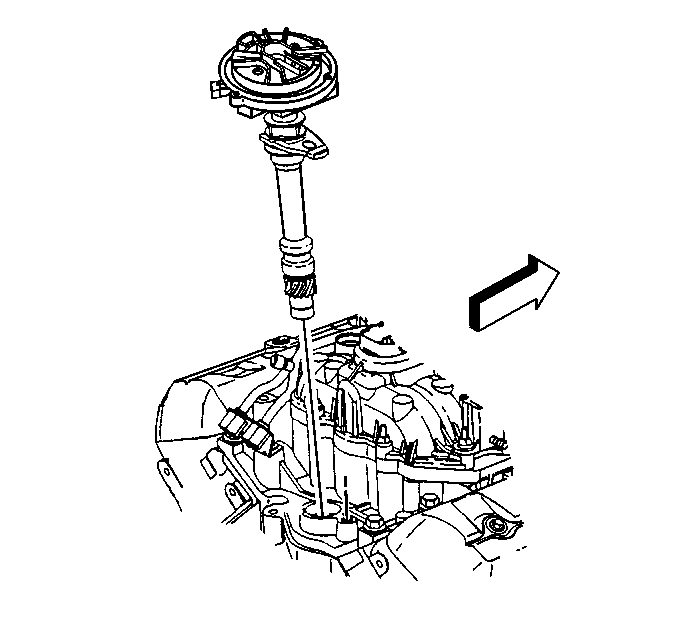
- Remove the distributor. Refer to
Distributor Replacement
in Engine Electrical.
- Remove the radiator inlet hose at the water outlet.
- Remove the heater hose from the intake manifold.
- Remove the water pump inlet hose from the intake manifold.

- Remove the accelerator
control cable from the throttle shaft. Refer to Accelerator Controls Cable Replacement
in Engine Controls.
- Disconnect the cruise control cable, if equipped. Refer to
Cruise Control Cable Replacement
in Cruise Control.
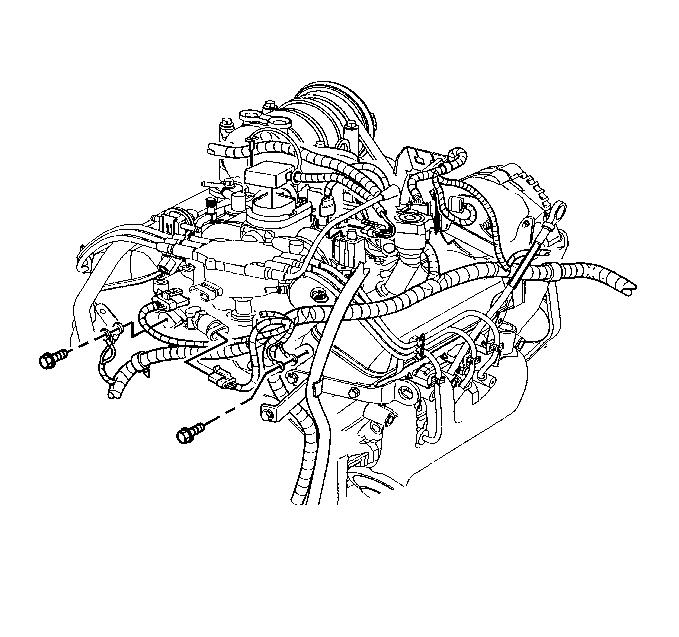
- Disconnect the following
electrical connectors:
| • | The fuel meter body assembly |
| • | The EVAP canister purge solenoid valve |
| • | The A/C compressor high pressure switch |
| • | The ignition control module (ICM) |
| • | The idle air control (IAC) motor |
| • | The throttle position (TP) sensor |
| • | The exhaust gas recirculation (EGR) valve |
| • | The engine coolant temperature (ECT) sensor |
- Remove the engine wire harness from the retainers.
- Move the engine wire harness aside.

- Remove the inlet pipe
and the clamp bolt from the exhaust gas recirculation valve (EGR).
- Disconnect the fuel pipes at the rear of the intake manifold.
- Disconnect the vacuum hose for the A/C system from the intake
manifold.
- Disconnect the vacuum brake booster hose from the intake manifold.

- Disconnect the PCV hose
from the intake manifold.
- Remove the purge solenoid valve studs from the EVAP canister.
- Remove the purge solenoid valve from the EVAP canister.
- Remove the fuel pipes from the rear of the intake manifold.
Refer to
Fuel Hose/Pipes Replacement - Engine Compartment
in Engine Controls.
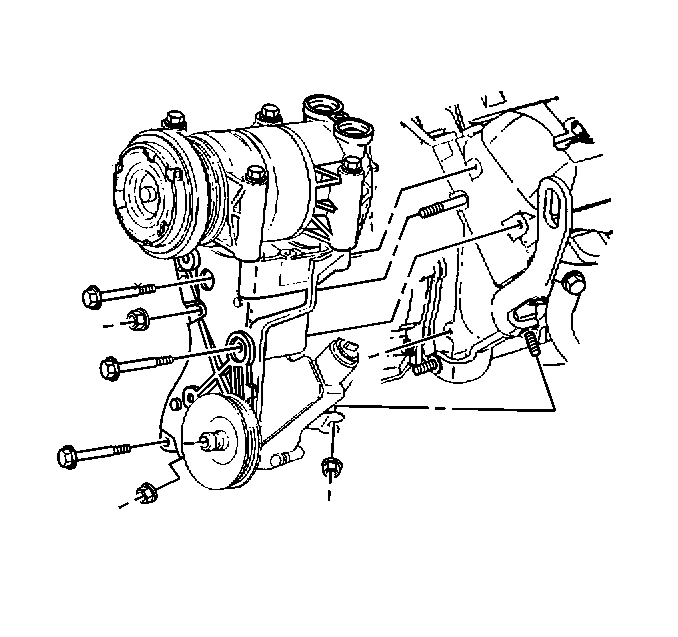
Important: Do not discharge the A/C refrigerant.
- Perform the following in order to remove the left front bolt from the
intake manifold:
| 22.1. | Remove the drive belt. Refer to Drive Belt Replacement
. |
| 22.2. | Loosen the nut for the power steering pump rear bracket at the
side of the engine. |
| 22.3. | Remove the rear bracket nut for the power steering pump at the
front of the engine. |
| 22.4. | Remove the bolts and the nut for the power steering pump bracket. |
| 22.5. | Leave the A/C compressor and power steering pump on the power
steering pump bracket. |
| 22.6. | Slide the power steering pump bracket forward in order to access
the bolt at the front of the intake manifold. |
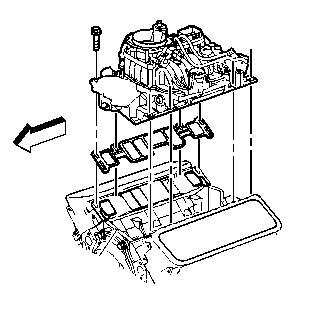
- Remove the lower intake manifold. Refer to Intake Manifold Removal
.
- Clean all sealing surfaces. Refer to
Cylinder Head Cleaning and Inspection
and
Intake Manifold Cleaning and Inspection
.
Installation Procedure

Notice: Proper lower intake manifold fastener tightening sequence
and torque is critical. Always follow the tightening sequence, and torque
the intake manifold bolts using the 3 step method. Failing to do so may distort
the crankshaft bearing bore alignment and cause damage to the crankshaft bearings.
- Install the lower intake manifold. Refer to Intake Manifold Installation
.
- Transfer parts to the new lower intake manifold. Refer to
Intake Manifold Disassemble
and
Intake Manifold Assemble
.

- Position the power steering
pump bracket.
- Loosely install the power steering pump bracket bolts and the
nuts.
Notice: Use the correct fastener in the correct location. Replacement fasteners
must be the correct part number for that application. Fasteners requiring
replacement or fasteners requiring the use of thread locking compound or sealant
are identified in the service procedure. Do not use paints, lubricants, or
corrosion inhibitors on fasteners or fastener joint surfaces unless specified.
These coatings affect fastener torque and joint clamping force and may damage
the fastener. Use the correct tightening sequence and specifications when
installing fasteners in order to avoid damage to parts and systems.
- Install the nut
for the power steering pump rear bracket at the front of the engine.
Tighten
Tighten the bolts and the nuts to 41 N·m (30 lb ft).
- Install the drive belt. Refer to Drive Belt Replacement
.

- Install the PCV hose to
the intake manifold.
- Connect the vacuum brake booster hose to the intake manifold.
- Connect the vacuum hose for the A/C system to the intake manifold.
- Install EVAP canister purge solenoid valve. Refer toEVAP Canister Purge Solenoid Valve Replacement
in
Engine Controls.
- Install the fuel pipes to the rear of the intake manifold. Refer
to
Fuel Hose/Pipes Replacement - Engine Compartment
in Engine Controls.

- Install the inlet pipe
clamp bolt to the exhaust gas recirculation (EGR).
Tighten
- Tighten nut to 25 N·m (18 lb ft).
- Tighten the EGR valve inlet pipe exhaust manifold nut to 30 N·m
(22 lb ft).
- Tighten the EGR valve inlet pipe clamp bolt to 25 N·m
(18 lb ft).
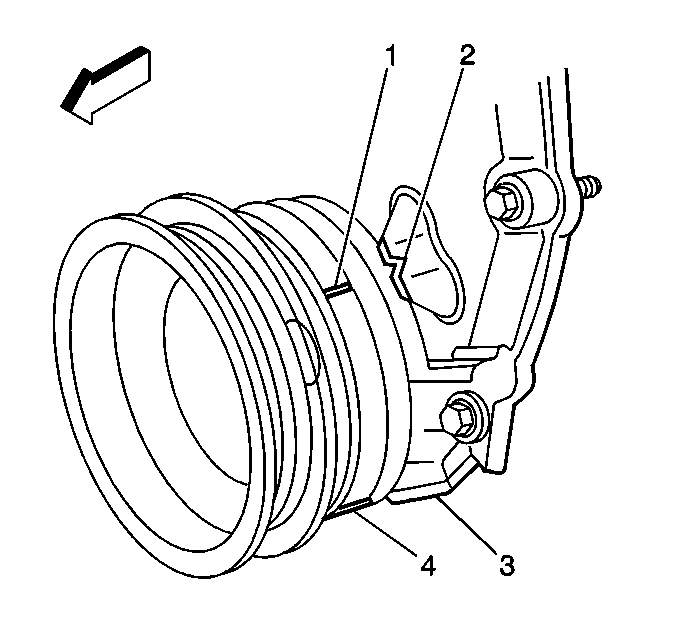
Important: In order to install the distributor with the correct engine timing,
position the engine to number one cylinder to top dead center.
- Remove the spark plug from the number one cylinder.
- Rotate the crankshaft until the number one cylinder is in the
compression stroke.
- Align the 2 reference marks on the crankshaft balancer (1)
and (4) with the 2 alignment marks (2) and (3) on the
front cover.
- Install the spark plug in the number one cylinder. Refer to
Spark Plug Replacement
in Engine
Electrical.
- Install the distributor. Refer to
Distributor Replacement
in Engine Electrical.

- Position the engine wiring
harness.
- Install the engine wiring harness in the retainers.
- Connect the following electrical connectors:
| • | The fuel meter body assembly |
| • | The EVAP canister purge solenoid valve |
| • | The A/C compressor high pressure switch |
| • | The ignition control module (ICM) |
| • | The idle air control (IAC) motor |
| • | The throttle position (TP) sensor |
| • | The exhaust gas recirculation (EGR) valve |
| • | The engine coolant temperature (ECT) sensor |

- Install the accelerator
control cable and the bracket to the throttle shaft. Refer to Accelerator Controls Cable Replacement
in Engine
Controls.
- Install the cruise control cable, if equipped. Refer to
Cruise Control Cable Replacement
in Cruise Control.
- Install the water pump inlet hose to the intake manifold.
- Install the heater hose to the intake manifold.
- Install the radiator inlet hose to the water outlet.
- Install the air cleaner outlet duct to the throttle body. Refer
to
Air Cleaner Outlet Duct Replacement
in Engine Controls.
- Connect the PCV tube to the air cleaner outlet duct.
- Fill the cooling system. Refer to
Cooling System Draining and Filling
in Engine Cooling.
- Connect the battery negative cable. Refer to
Battery Cable Replacement
in Engine Electrical.

























